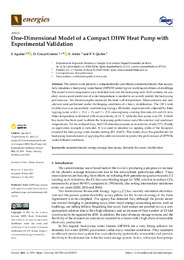Por favor, use este identificador para citar o enlazar este ítem:
https://hdl.handle.net/11000/34220Registro completo de metadatos
| Campo DC | Valor | Lengua/Idioma |
|---|---|---|
| dc.contributor.author | Aguilar, F. | - |
| dc.contributor.author | Crespí Llorens, Damián | - |
| dc.contributor.author | Aledo, S. | - |
| dc.contributor.author | Quiles, P. V. | - |
| dc.contributor.other | Departamentos de la UMH::Ingeniería Mecánica y Energía | es_ES |
| dc.date.accessioned | 2025-01-08T11:42:29Z | - |
| dc.date.available | 2025-01-08T11:42:29Z | - |
| dc.date.created | 2021-05 | - |
| dc.identifier.citation | Energies 2021, 14, 2 | es_ES |
| dc.identifier.issn | 1996-1073 | - |
| dc.identifier.uri | https://hdl.handle.net/11000/34220 | - |
| dc.description.abstract | The current work presents a computationally cost-effective numerical model that successfully simulates a heat pump water heater (HPWH) under typical working conditions of dwellings. The model’s main components are a stratified tank and the heat-pump unit. Both systems are coupled, since a good prediction of water temperature is needed to accurately predict the heat-pump performance. Ten thermocouples measured the tank wall temperature. Measurements and simulations were performed under challenging conditions of a heavy stratification. The 190 L tank stratification was successfully modeled employing a 1D model, experimentally adjusted by three Citation: Aguilar, F.; Crespí-Llorens, D.; Aledo, S.; Quiles, P.V. One-Dimensional Model of a Compact DHWHeatPumpwith Experimental Validation. Energies 2021, 14, 2991. https://doi.org/ 10.3390/en14112991 Academic Editor: Alessia Arteconi Received: 19 April 2021 Accepted: 15 May 2021 Published: 21 May 2021 Publisher’s Note: MDPI stays neutral with regard to jurisdictional claims in published maps and institutional affiliations. Copyright: © 2021 by the authors. Licensee MDPI, Basel, Switzerland. This article is an open access article distributed under the terms and conditions of the Creative Commons Attribution (CC BY) license (https:// creativecommons.org/licenses/by/ 4.0/). tapping cycles, with 6 × 22, 6 × 33, and 3 × 33 L consumptions, covering flowrates of 4 and 6 L/min. Water temperature is obtained with an uncertainty of 2.6 ◦C while the heat-pump was ON. A black box model has been used to obtain the heat-pump performance out of the external and condenser temperatures. For the analyzed days, theCOPestimation presents an uncertainty of only 5.1%. Finally, an application example is included. It was used to simulate six tapping cycles of the European standard for heat pump water heaters testing (EN 16147). The results show the possibilities for heat-pump manufacturers of applying this calibrated model to predict the performance of HPWHs under different conditions. | es_ES |
| dc.format | application/pdf | es_ES |
| dc.format.extent | 19 | es_ES |
| dc.language.iso | eng | es_ES |
| dc.publisher | MDPI | es_ES |
| dc.rights | info:eu-repo/semantics/openAccess | es_ES |
| dc.rights.uri | http://creativecommons.org/licenses/by-nc-nd/4.0/ | * |
| dc.subject | numerical model | es_ES |
| dc.subject | energy storage | es_ES |
| dc.subject | heat pump | es_ES |
| dc.subject | domestic hot water | es_ES |
| dc.subject | stratification | es_ES |
| dc.subject.other | CDU::6 - Ciencias aplicadas::62 - Ingeniería. Tecnología | es_ES |
| dc.title | One-Dimensional Model of a Compact DHWHeat Pumpwith Experimental Validation | es_ES |
| dc.type | info:eu-repo/semantics/article | es_ES |
| dc.relation.publisherversion | https://doi.org/10.3390/en14112991 | es_ES |

Ver/Abrir:
energies-14-02991 (1).pdf
2,21 MB
Adobe PDF
Compartir:
 La licencia se describe como: Atribución-NonComercial-NoDerivada 4.0 Internacional.
La licencia se describe como: Atribución-NonComercial-NoDerivada 4.0 Internacional.
.png)